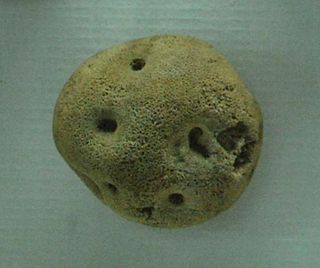
Murex is a genus of medium to large sized predatory tropical sea snails. These are carnivorous marine gastropod molluscs in the family Muricidae, commonly called "murexes" or "rock snails".

Arisaema is a large and diverse genus of the flowering plant family Araceae. The largest concentration of species is in China and Japan, with other species native to other parts of southern Asia as well as eastern and central Africa, Mexico and eastern North America. Asiatic species are often called cobra lilies, while western species are often called jack-in-the-pulpit; both names refer to the distinctive appearance of the flower, which consists of an erect central spadix rising from a spathe.

Tube feet are small active tubular projections on the oral face of an echinoderm, whether the arms of a starfish, or the undersides of sea urchins, sand dollars and sea cucumbers; they are more discreet though present on brittle stars, and have only a feeding function in feather stars. They are part of the water vascular system.
Sphingomonas echinoides is a Gram-negative soil bacterium.

Cameraria leucothorax is a moth of the family Gracillariidae. It is known from California and Oregon in the United States.
Cameraria walsinghami is a moth of the family Gracillariidae. It is known from California, United States.

Copiapoa atacamensis is a species of cactus from the Atacama Desert in the province of Antofagasta in northern Chile. Its relationship with other species of Copiapoa, such as C. calderana, are unclear as of April 2012.

Malawispongiidae is a family of freshwater sponges found in the ancient lakes of Malawi, Tanganyika, Kinneret, Ohrid and Poso. As presently defined, the family is polyphyletic.

Apomecynini is a tribe of longhorn beetles of the subfamily Lamiinae.
Phrynidius is a genus of beetles in the family Cerambycidae, containing the following species:
Phrynidius armatus is a species of beetle in the family Cerambycidae. It was described by Linsley in 1933.
Phrynidius asper is a species of beetle in the family Cerambycidae. It was described by Henry Walter Bates in 1885.
Phrynidius echinus is a species of beetle in the family Cerambycidae. It was described by Bates in 1880. It is known from Honduras, Guatemala, and Panama.
Phrynidius inaequalis is a species of beetle in the family Cerambycidae. It was described by Say in 1835. It is known from Mexico and Honduras.
Phrynidius salvadorensis is a species of beetle in the family Cerambycidae. It was described by Franz in 1954. It contains two subspecies, P. salvadorensis montecristensis and P. salvadorensis salvadorensis.
Phrynidius singularis is a species of beetle in the family Cerambycidae. It was described by Bates in 1880. It is known from Mexico, Guatemala, and Honduras.
Methylocystis echinoides is a bacterium species from the genus of Methylocystis.
Neesiella is a genus of liverworts belonging to the family Aytoniaceae.
Lobostemon echioides, the common healthbush, is the mostly widely distributed species in its genus. It is endemic to South Africa, where it is found growing between Namaqualand and the Karoo and the Eastern Cape.

Figularia is a genus of bryozoans belonging to the family Cribrilinidae.






